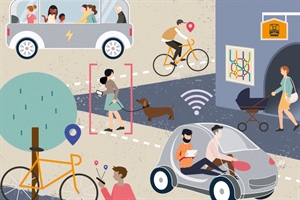Whether autonomous cars are good for environment depends on policy choices - report
Fri 04 October 2019
View all news

A new report from Brussels-based NGO Transport and Environment says that the unregulated arrival of driverless cars could increase traffic in Europe's cities by 50% to 150% by 2050. It says that a ‘Wild West’ unregulated increase in driverless cars – as anticipated by some in the industry – could result in 40% more CO2 emissions from cars between now and 2050, making Europe's climate goals all but impossible to achieve.
T&E says that technology alone won’t make our mobility system more sustainable; and policy choices will be crucial in shaping future mobility revolutions. In particular, the European Union and the member states must lever these new developments to reach our climate objective of keeping emissions well below 2°C envelope and focus on ensuring liveable cities.
The authors say that risks are already visible today, as app-based ride sharing platforms such as Uber encourage new trips and lead to more kilometres driven, increasing emissions, and worsening congestion. In a scenario where such vehicles are automated, the cost of these services is expected to drop sharply (perhaps by more than 50%) and as a consequence, demand to sharply increase.
T&E's analysis says that automated vehicles with no driver could become so cheap to run that they would encourage people, or even cars without people in them, to travel more and for longer. To ensure driverless vehicles do not lead to increased CO2 emissions, the authors say, cities should refuse access for automated combustion engine cars.
The study shows that zero-emission, driverless cars, even if they are actively shared, will not solve the congestion problems in Europe’s cities. This is because such vehicles will be ultra-cheap and ultra-convenient creating an increase in demand for car travel quickly filling any road space that might become available. The additional car travel could come from public transport users, active travel such as cycling or simply higher overall travel demand.
Based on the report's modelling, the authors say that vehicle activity could be reduced by 60% in cities which consider gradually reducing space for cars while simultaneously rolling out shared, electric, automated cars. Such changes in urban planning would reduce emissions from cars by over 30% between now and 2050 which, combined with a shift to zero-emission vehicles, would put European car emissions on track to completely decarbonise transport by 2050, the authors say.
Yoann Le Petit, new mobility expert at T&E, said: “Automation, electrification and sharing are three revolutions that can transform the way we move around. But whether this will be a good thing for the environment or for the livability of our cities depends entirely on the choices governments make. If we want sustainable mobility we need to ban driverless cars with combustion engines and gradually reduce road space for cars in our cities. We need mayors across Europe to press on with this fourth revolution and reclaim the streets for their people."
T&E's report explores a range of possible futures: will automated vehicles be so cheap that they encourage people, or even vehicles without people in them, to travel more and for longer, causing more congestion and more car dominated cities, exacerbating the current mobility system’s failings? Or will they be electric, shared and integrated holistically with other mobility options such as public transport and new (micro)mobility? The report includes four scenarios to show the possible outcomes of these revolutions.
Visit T&E's website to download the report (
link).
Related Links
< Back to news list